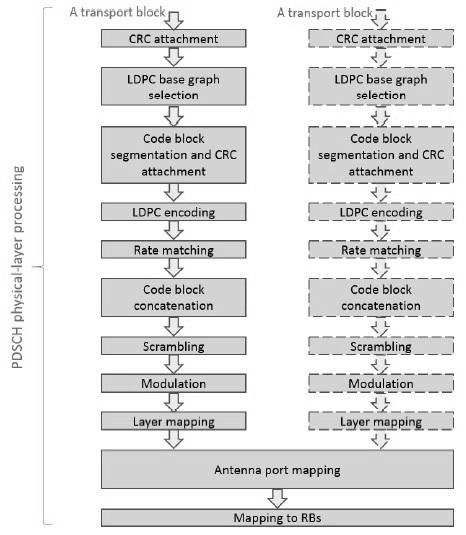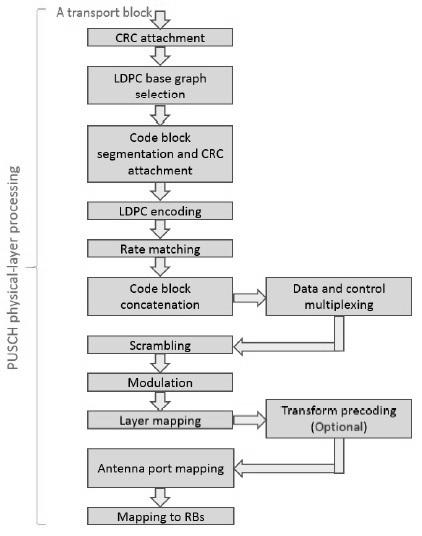5G NR Physical Layer Overview: Modules and Processing
Advertisement
This article provides an overview of the 5G NR (New Radio) physical layer modules, based on the 3GPP standard. It describes the processing of PDSCH and PUSCH channels within the 5G physical layer.
Introduction
The 5th generation wireless access technology is known as NR (New Radio). It follows the 3GPP series of standards, similar to GSM, CDMA, and LTE. 3GPP has been developing specifications for 5G NR for several years. The first specifications were published in Dec. 2017, supporting NSA (Non-Standalone) where a 5G compliant UE relies on existing LTE for initial access and mobility.
In June 2018, SA (Standalone) versions of 5G NR specifications were finalized, enabling independent operation from LTE.
There are three primary use cases for 5G NR technology:
- eMBB (Enhanced Mobile Broadband)
- mMTC (Massive Machine Type Communications)
- URLLC (Ultra-Reliable Low Latency Communication)
The 5G PHY layer is specified in the 3GPP TS 38.200 series of documents. There are two main components in a 5G NR network:
- UE (User Equipment, i.e., mobile subscriber)
- gNB (Base Station)
gNBs are connected to the 5G Core network in the backend. The connection from gNB to UE is known as the downlink, which uses PBCH, PDSCH, and PDCCH channels for carrying different data/control information.
The connection from UE to gNB is known as the uplink, which uses PRACH, PUSCH, and PUCCH channels.
5G NR Numerology
5G NR supports two frequency ranges:
- FR1 (Sub 6GHz)
- FR2 (millimeter wave range, 24.25 to 52.6 GHz)
NR uses flexible subcarrier spacing derived from the basic 15 KHz subcarrier spacing used in LTE. The CP (Cyclic Prefix) length is chosen accordingly. This is shown in Table 1.
Table 1: μ, Subcarrier spacing, CP, PRBs
| μ | Δf = 2μ .15 | Cyclic Prefix |
|---|---|---|
| 0 | 15 KHz | Normal |
| 1 | 30 KHz | Normal |
| 2 | 60 KHz | Normal, Extended |
| 3 | 120 KHz | Normal |
| 4 | 240 KHz | Normal |
| 5 | 480 KHz | Normal |
Both frequency ranges FR1 and FR2 use different 5G numerology as mentioned in Table 2. Subcarrier Spacing of 15/30 KHz is supported for below 6 GHz 5G NR, while 60/120/240 KHz is supported for mmWave bands.
A maximum bandwidth of 100 MHz is supported in sub-6 GHz, whereas 400 MHz is supported in mmWave frequency ranges. In LTE, a maximum BW of 20 MHz was used.
Table 2: 5G NR Sub-6 GHz and mmWave parameters as per 3GPP Rel.15
| Parameters | Sub-6 GHz range | mmWave range |
|---|---|---|
| Carrier aggregation | Up to 16 carriers | |
| BW per carrier | 5/10/15/20/25/40/50/60/80/100 MHz | 50/100/200/400 MHz |
| Subcarrier spacing | 15/30/60 KHz | 60/120/240 KHz |
| Modulation Scheme | DL/UL: 256 QAM | |
| MIMO | DL: up to 8 layers, UL: up to 4 layers | DL: up to 2 layers, UL: up to 2 layers |
| Duplex mode | TDD (focus), FDD | TDD |
| Access scheme | DL: CP-OFDM, UL: CP-OFDM, DFT spread OFDM |
Table 3: Subcarrier spacing, Number of OFDM symbols and slots
| Subcarrier spacing (KHz) | 15 | 30 | 60 | 120 | 240 |
|---|---|---|---|---|---|
| Symbol duration (µs) | 66.7 | 33.3 | 16.7 | 8.33 | 4.17 |
| CP duration (µS) | 4.7 | 2.3 | 1.2 (Normal CP), 4.13 (Extended CP) | 0.59 | 0.29 |
| Max. nominal system BW (MHz) | 50 | 100 | 100 (sub-6 GHz), 200 (mmwave) | 400 | 400 |
| FFT size (max.) | 4096 | 4096 | 4096 | 4096 | 4096 |
| Symbols per slot | 14 | 14 | 14 (normal CP), 12 (extended CP) | 14 | 14 |
| Slots per subframe | 1 | 2 | 4 | 8 | 16 |
| Slots per frame | 10 | 20 | 40 | 80 | 160 |
5G NR Frame Structure

A frame has a duration of 10 ms, consisting of 10 subframes, each with a 1ms duration, similar to LTE technology. Each subframe can have 2μ slots. Each slot typically consists of 14 OFDM symbols. The radio frames of 10 ms are transmitted continuously as per the TDD topology, one after the other. A subframe is of fixed duration (i.e., 1ms), whereas the slot length varies based on subcarrier spacing and the number of slots per subframe. As shown below, it is 1 ms for 15 KHz, 500 µs for 30 KHz, and so on. Each slot occupies either 14 OFDM symbols or 12 OFDM symbols based on normal CP and extended CP, respectively.

5G NR supports the Mini Slot concept, which helps in achieving very low latency in data transmission. It supports 2, 4, or 7 OFDM symbols.

The figure depicts the resource grid of 5G NR with symbols on the time axis and subcarriers on the frequency axis. 12 subcarriers form one PRB (Physical Resource Block). 5G NR supports 24 to 275 PRBs in a single slot. An occupied BW of 34.56 MHz (minimum) and 396 MHz (maximum) can be achieved for 120 KHz subcarrier spacing.
One SS/PBCH Block occupies 4 OFDM Symbols in the time domain and 24 PRBs in the frequency domain. 5G NR SS consists of PSS and SSS as specified for LTE.
Understanding 5G Physical Layer using PDSCH and PUSCH
In 5G NR, there are various physical channels in the downlink (from gNB to UE) and uplink (from UE to gNB).
- Downlink channels: PDSCH, PDCCH, PBCH
- Uplink channels: PRACH, PUSCH, PUCCH
There are specific physical signals present in both downlink and uplink for various purposes. Front-loaded DMRS (Demodulation Reference Signal) is used for both PDSCH and PUSCH channels.
We will consider OFDM with CP for both downlink and uplink chains. Uplink also uses DFT Spread OFDM with CP for improved coverage.
PDSCH channel processing through 5G NR Physical layer

Let us understand PDSCH channel processing using 5G NR physical layer modules. The PDSCH channel is used to carry DL user data, UE-specific upper-layer information (layer-2 and above), system information, and paging.
Let us understand PDSCH channel data (i.e., transport block) processing through 5G NR physical layer modules or blocks. Transport block size calculation is mentioned in 3GPP TS 38.214 (section 5.1.3.2).
- As shown in the figure, CRC is added to each of the transport blocks to provide error detection.
- This is followed by LDPC base graph as per transport block size (small or large).
- Now, the transport block is segmented into code blocks. CRC is appended to each of these code blocks.
- Each of the code blocks are individually encoded using LDPC encoder, which are rate matched after the encoding process.
- Code block concatenation is performed to form codewords for transmission over the PDSCH channel. About 2 codewords are transmitted simultaneously on a single PDSCH channel. A single codeword is used for 1 to 4 layers, whereas 2 codewords are used for 5 to 8 number of layers.
- All the codewords are scrambled and modulated to generate complex data symbols before layer mapping. It uses QPSK, 16QAM, 64QAM, and 256QAM modulation schemes.
- The modulated data symbols are mapped to either 4 or 8 layers.
- The layers are mapped with the number of antenna ports reserved for PDSCH use, and complex modulated data symbols are mapped to RBs (Resource Blocks) in the resource grid as per subcarrier spacing. Antenna ports range is {1000,…,1011}.
- DMRS values are inserted during resource element mapping, used for channel estimation and equalization at the UE receiver. An OFDM signal is generated after RE (Resource Element) mapping.
- The downlink PDSCH is received by UE, which consists of reverse modules of 5G NR physical layer in order to decode the transport block back before passing the information to upper layers.
PUSCH channel processing through 5G Physical layer

Let us understand PUSCH channel data (i.e., transport block) processing through 5G physical layer modules or blocks. The PUSCH channel is used for the transmission of UL SCH and layer-1 and layer-2 control information.
The procedure for UL transport block in PUSCH processing is the same as described above. It uses an additional π/2-BPSK modulation scheme in addition to the ones listed above in PDSCH processing. It also uses DMRS signals for channel estimation and equalization process to help in decoding process.
- In addition to the above blocks, the PUSCH processing uses transform precoding after the layer mapping operation. This is optional and UE implementation specific. DFT transform precoding is used for single-layer transmissions. PUSCH supports a single codeword which can be mapped maximum up to 4 layers.
- 5G NR UE uses codebook-based transmission and non-codebook-based transmissions.
- In 5G NR, mapping to the resource grid is done frequency-wise first before time in order to have an easier decoding process at the gNB receiver.
5G PHY layer (5G L1) References
5G physical layer (L1) specifications are defined in the following 3GPP 5G New Radio (NR) series of documents.
- 3GPP TS 38.201: General description
- 3GPP TS 38.202: Services provided by the physical layer
- 3GPP TS 38.211: Physical channels and modulation
- 3GPP TS 38.212: Multiplexing and channel coding
- 3GPP TS 38.213: Physical layer procedures for control
- 3GPP TS 38.214: Physical layer procedures for data
- 3GPP TS 38.215: Physical layer measurements
Advertisement
 RF
RF


